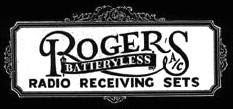 I don't' write much about Canadian radio. I try to narrow my focus to the U.S. History is a many splendored muddy mess. Without a narrow focus there is no cohesion. But Ted did something that mattered everywhere to every radio. So for him I'll bend the rules a little.
I don't' write much about Canadian radio. I try to narrow my focus to the U.S. History is a many splendored muddy mess. Without a narrow focus there is no cohesion. But Ted did something that mattered everywhere to every radio. So for him I'll bend the rules a little.When people write about Edward "Ted" Samuel Rogers, they normally follow his name with adjectives like pioneer and visionary. By the age of 11, in the year 1912 he was already broadcasting with a spark gap transmitter. He had one of the very first amateur licenses on Canada. His call sign was 3BP on 300 meters. He was ahead of the curve in every way. In 1921 he successfully transmitted a signal across the Atlantic in an ARRL competition.
In 1922 he builds another radio station 9AH for the Toronto Star the local daily news paper. It later becomes CFCA and is the first commercial radio station in Toronto. Prior to 1925 all
 broadcasting and receiving required a battery. Ted fixed that. He invented the world's first alternating current radio tube. This was huge. A radio could now be plugged into an ordinary 110v wall outlet.As a side benefit switching from DC to AC eliminates the hum of battery power. Radio audio is significantly clearer.
broadcasting and receiving required a battery. Ted fixed that. He invented the world's first alternating current radio tube. This was huge. A radio could now be plugged into an ordinary 110v wall outlet.As a side benefit switching from DC to AC eliminates the hum of battery power. Radio audio is significantly clearer.He founded the Standard Radio Manufacturing Corporation in Toronto and began cranking out AC powered radios. rapidly they became a huge manufacturer and supplier of radios for all of North America.
The next year he followed that up by founding the world's first battery-free radio station CFRB. And CFRB is still on the air today but many people have forgotten that their calls stand for Canada's First Rogers Batteryless. But Ted kept rolling. He was first to develop a power rectifier pentad tube, and the spray-shield tube. In 1931, Rogers was granted the first television license. In the middle of a winning streak he died suddenly of an aneurysm at the age of 39.
 His son, Ted, Jr. eventually took over Rogers Telecommunications and did right by his dad. Ted Jr. popularized FM radio in Canada, and built a communications empire. While in the U.S he's downplayed in history (Like the Ruskies taking Berlin!) Canada celebrates him. They released a set of stamps commemorating his contributions in 2000. That same year the Gage Publishing Company released a somwhat lionized but good biography. At the University of Toronto the Electrical Engineering Department is named after him. There his reputation verges on folk hero, which in all honestly is closer to the truth.
His son, Ted, Jr. eventually took over Rogers Telecommunications and did right by his dad. Ted Jr. popularized FM radio in Canada, and built a communications empire. While in the U.S he's downplayed in history (Like the Ruskies taking Berlin!) Canada celebrates him. They released a set of stamps commemorating his contributions in 2000. That same year the Gage Publishing Company released a somwhat lionized but good biography. At the University of Toronto the Electrical Engineering Department is named after him. There his reputation verges on folk hero, which in all honestly is closer to the truth.




No comments:
Post a Comment